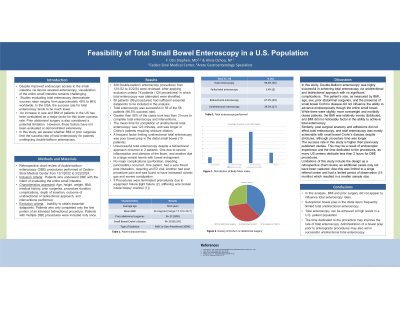Tuesday Poster Session
Category: Small Intestine
P4939 - Feasibility of Total Small Bowel Enteroscopy Via Double-Balloon Enteroscopy in a US Population
Tuesday, October 29, 2024
10:30 AM - 4:00 PM ET
Location: Exhibit Hall E

Has Audio
- OS
Otis Stephen, MD
Cedars-Sinai Medical Center
Beverly Hills, CA
Presenting Author(s)
F. Otis stephen, MD1, Alisa Ochoa, FNP2
1Cedars-Sinai Medical Center, Beverly Hills, CA; 2Cedars-Sinai Medical Center, Hollywood, CA
Introduction: Despite improved endoscopic access to the small intestine via various methods of device assisted enteroscopy, visualization of the entire small intestine endoscopically remains challenging. Successful total enteroscopy in the literature ranges from approximately 45% to 86% worldwide. However, in the USA the success rate tends to be much lower. A suspected increased BMI of patients in the US has been suggested as the cause of this discrepancy. Prior abdominal surgeries are also suspected to play a role in limiting total enteroscopy, but these factors have not been evaluated extensively. In this study, we assess whether BMI or prior surgeries limit the success rate of total enteroscopy.
Methods: A retrospective chart review of double-balloon enteroscopy (DBE) procedures performed at a single high volume center from 12/1/2022 to 3/22/2024 was performed. Patients who underwent DBE with the intent of evaluating the entire small intestine via DBE were extracted from the database. Characteristics assessed include age, height, weight, BMI, medical history, prior surgeries, and successful total small bowel enteroscopy from a unidirectional or bidirectional approach, and the type of interventions performed were recorded.
Results: 58 patients were identified in which total enteroscopy was attempted. Total enteroscopy was achieved in 96.5% (56) of these patients. Average age was 56.6 years, mean BMI was 25.43 (range 17.0 to 34.7 (mean 25.43). 22 patients had prior abdominal surgeries. 20 patients had a history of Crohn’s disease. Greater than 95% of the cases took less than 3 hours to complete total enteroscopy with interventions. Total enteroscopy from an anterograde approach occurred in 17 patients and was frequently limited by poor bowel prep in the distal small bowel. Unsuccessful total enteroscopy occurred in 1 patient with severe inflammation and stenosis of the ileum, and in a 2nd patient with a large ventral hernia with bowel entrapment.
Discussion: In this analysis, weight, BMI, and prior abdominal surgeries were not significant limitations for achieving total enteroscopy. Suboptimal bowel prep in the distal ileum frequently limited total unidirectional enteroscopy.
Total enteroscopy can be achieved at high levels in a U.S. patient population. The time dedicated to the procedure may improve the rate of total enteroscopy. Administration of a bowel prep prior to anterograde procedures may also aid in successful unidirectional total enteroscopy.
Disclosures:
F. Otis stephen, MD1, Alisa Ochoa, FNP2. P4939 - Feasibility of Total Small Bowel Enteroscopy Via Double-Balloon Enteroscopy in a US Population, ACG 2024 Annual Scientific Meeting Abstracts. Philadelphia, PA: American College of Gastroenterology.
1Cedars-Sinai Medical Center, Beverly Hills, CA; 2Cedars-Sinai Medical Center, Hollywood, CA
Introduction: Despite improved endoscopic access to the small intestine via various methods of device assisted enteroscopy, visualization of the entire small intestine endoscopically remains challenging. Successful total enteroscopy in the literature ranges from approximately 45% to 86% worldwide. However, in the USA the success rate tends to be much lower. A suspected increased BMI of patients in the US has been suggested as the cause of this discrepancy. Prior abdominal surgeries are also suspected to play a role in limiting total enteroscopy, but these factors have not been evaluated extensively. In this study, we assess whether BMI or prior surgeries limit the success rate of total enteroscopy.
Methods: A retrospective chart review of double-balloon enteroscopy (DBE) procedures performed at a single high volume center from 12/1/2022 to 3/22/2024 was performed. Patients who underwent DBE with the intent of evaluating the entire small intestine via DBE were extracted from the database. Characteristics assessed include age, height, weight, BMI, medical history, prior surgeries, and successful total small bowel enteroscopy from a unidirectional or bidirectional approach, and the type of interventions performed were recorded.
Results: 58 patients were identified in which total enteroscopy was attempted. Total enteroscopy was achieved in 96.5% (56) of these patients. Average age was 56.6 years, mean BMI was 25.43 (range 17.0 to 34.7 (mean 25.43). 22 patients had prior abdominal surgeries. 20 patients had a history of Crohn’s disease. Greater than 95% of the cases took less than 3 hours to complete total enteroscopy with interventions. Total enteroscopy from an anterograde approach occurred in 17 patients and was frequently limited by poor bowel prep in the distal small bowel. Unsuccessful total enteroscopy occurred in 1 patient with severe inflammation and stenosis of the ileum, and in a 2nd patient with a large ventral hernia with bowel entrapment.
Discussion: In this analysis, weight, BMI, and prior abdominal surgeries were not significant limitations for achieving total enteroscopy. Suboptimal bowel prep in the distal ileum frequently limited total unidirectional enteroscopy.
Total enteroscopy can be achieved at high levels in a U.S. patient population. The time dedicated to the procedure may improve the rate of total enteroscopy. Administration of a bowel prep prior to anterograde procedures may also aid in successful unidirectional total enteroscopy.
Disclosures:
F. Otis stephen indicated no relevant financial relationships.
Alisa Ochoa indicated no relevant financial relationships.
F. Otis stephen, MD1, Alisa Ochoa, FNP2. P4939 - Feasibility of Total Small Bowel Enteroscopy Via Double-Balloon Enteroscopy in a US Population, ACG 2024 Annual Scientific Meeting Abstracts. Philadelphia, PA: American College of Gastroenterology.
